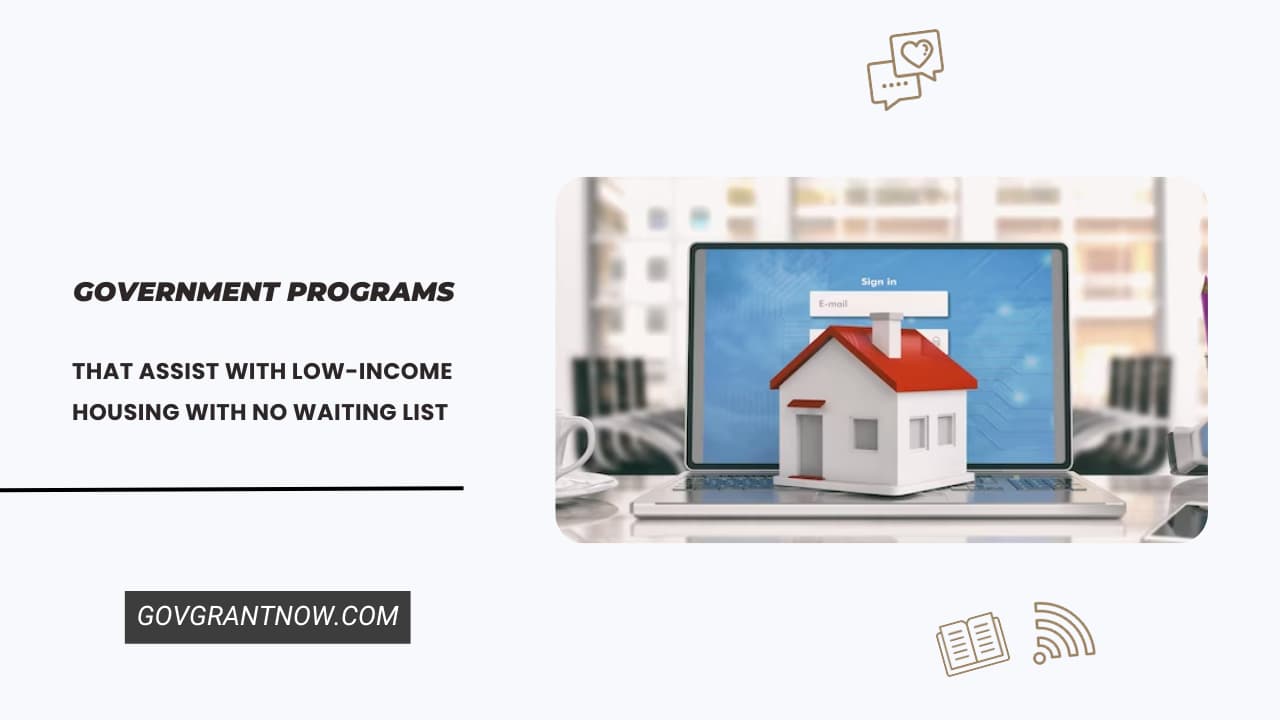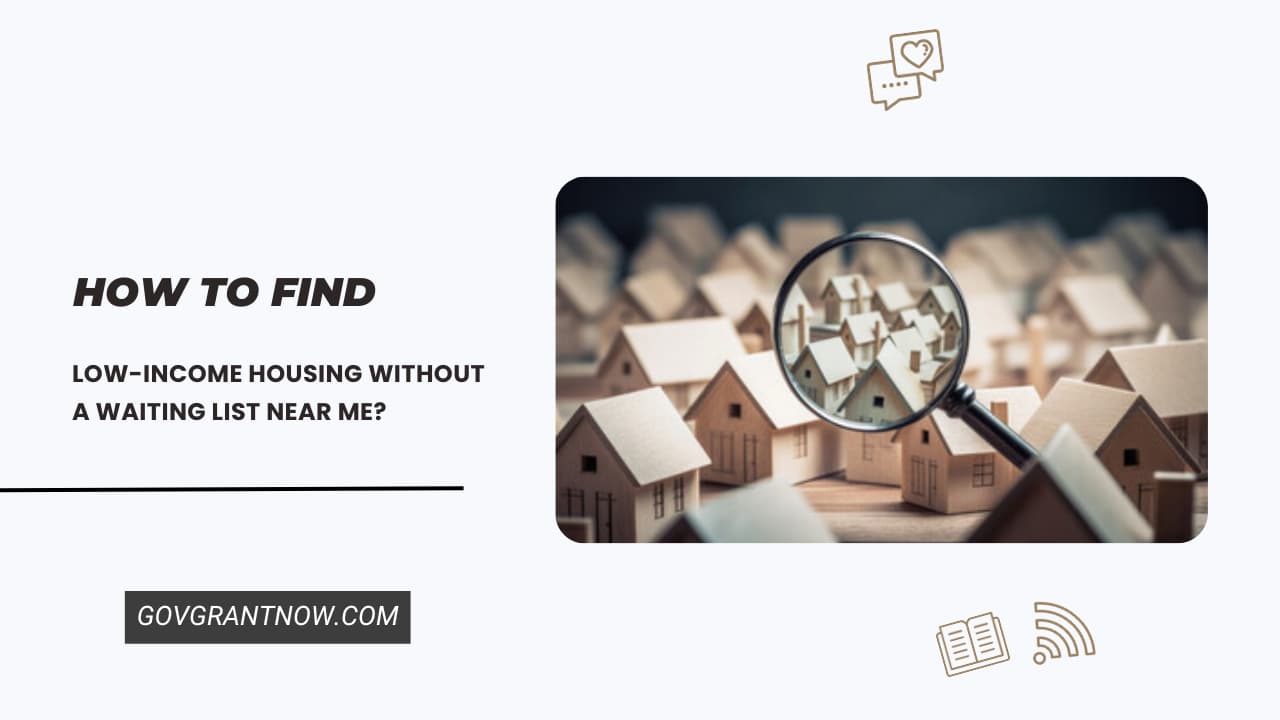In the current economic climate, the phrase low-income housing with no waiting list has become a beacon of hope for countless individuals and families.
This concept represents more than just a place to live; it signifies stability, security, and a chance to build a future free from the uncertainty of unaffordable rent.
Yet, for many, the reality of securing such housing seems like a distant dream.
In this comprehensive guide, we’ve discussed the process of getting low-income housing with no waiting list and the government programs and nonprofit organizations that help you get a home without having to endure long waiting list delays.
Table of Contents
Low-Income Housing with No Waiting List

Low-income housing with no waiting list represents an immediate opportunity for housing for those who fall within specific income brackets.
This contrasts sharply with the typical scenario where low-income apartments come with lengthy waiting lists, sometimes stretching to several years.
No waitlist low-income apartments are a rarity in the housing market, offering a swift reprieve to those who often find themselves in a precarious housing situation.
In the pursuit of such housing, one may encounter various terms like apartments for rent with no waiting list, subsidized apartments with no waiting list, and income-based apartments with no waiting list.
Each of these represents a facet of the broader category of immediate-access low-income housing.
They are pivotal for those who need stable housing to maintain employment, care for their families, and contribute to their communities without the looming stress of uncertain shelter.
Also Read: Income Restricted Apartments Near Me
How to Qualify for Low-Income Housing with No Waiting List?

To qualify for low-income housing with no waiting list usually involves several criteria that applicants must meet. While specific requirements may vary by program and location, here are some general eligibility factors:
1. Income Limits:
Eligibility is often based on the area median income (AMI) for the region where the housing is located. Most programs serve individuals and families whose income does not exceed 50% to 80% of the AMI.
Some programs, like those for extremely low-income households, may have thresholds as low as 30% of the AMI.
2. Family Status:
Certain housing programs are designed for specific family compositions, such as families with children, elderly individuals, or disabled family members.
The definition of a family can vary, and it’s important to understand how it is defined by the specific program.
3. Age and Disability:
Some housing options are available specifically for seniors or individuals with disabilities. These programs may have more lenient waiting lists or prioritize applicants based on their age or disability status.
4. Citizenship or Eligible Immigration Status:
Applicants typically must be U.S. citizens or have eligible immigration status to qualify for government-assisted housing programs.
5. Rental History and Background Checks:
A clean rental history may be required, with checks for previous evictions or debts to other housing programs. Criminal background checks are also common, and certain criminal records may disqualify applicants.
6. Local Residency:
Some housing authorities give preference to local residents or those who work in the area, which can affect eligibility and waiting list status.
7. Emergency Situations:
In emergency situations, such as natural disasters, domestic violence, or homelessness, applicants might be eligible for immediate housing through emergency vouchers or rapid rehousing programs.
8. Special Programs:
There are often special programs for veterans, the homeless, and other groups that may have different or additional eligibility criteria.
Also Read: Apartments With No Application Fee Near Me
How to Apply for Low-Income Housing With No Waiting List?

Applying for low-income housing, especially those options with no waiting list, involves several steps. Here’s a guide to help you through the process:
Step 1: Research Available Options
Start by searching for low-income housing options online. Look at government sites like HUD and local housing authority websites.
You can also find information through housing charities and non-profit organizations. They often list apartments that are available now or have shorter waiting lists.
Step 2: Understand the Requirements
Check what you need to qualify for these housing options. This usually involves showing how much money you make, which should be below a certain level.
You’ll need things like pay slips, tax returns, and a valid ID. Make sure you have all these documents ready.
Step 3: Contact Housing Providers
Get in touch with the housing providers you’ve found. Call them, send an email, or visit their office to ask about the application process.
They will let you know if they have immediate openings or if there’s a short waiting list you can join.
Step 4: Complete Application Process
Fill out the housing application forms with all the correct details. Double-check everything before you submit them to avoid any mistakes. You can usually submit these forms online, by mail, or in person.
Step 5: Follow Up
Once you’ve submitted your applications, don’t just wait. Call or email to make sure they’ve been received and ask how long the review process will take. Staying in touch shows you’re serious about finding a place.
Step 6: Prepare for Verification
Be ready for the housing provider to look into your rental history and do a credit check. They might also ask for references from people who know you, like former landlords or employers, to make sure you’re reliable.
Step 7: Ready to Secure Your Housing Opportunity
If you’re offered a housing spot, you’ll need to act quickly. Have your money ready for any application fees, deposits, and the first month’s rent. Also, think about how you’ll move your things to the new place.
Step 8: Expanding Your Housing Search and Options
Don’t just apply to one housing option; apply to several to better your chances of getting a place. If you can’t find a permanent home right away, consider short-term or transitional housing as a temporary solution while you keep looking.
Also Read: List of Churches That Will Help You Pay Your Rent
Government Programs That Assist with Low-Income Housing with No Waiting List

Securing a safe, affordable place to live can be a significant challenge, particularly for low-income individuals and families.
However, government programs designed to assist with housing needs can be a lifeline for those in dire straits.
Understanding and accessing low-income housing with no waiting list through these programs can provide much-needed relief and stability.
Here are some government programs that provide low-income housing with no waiting list:
1. Section 8 Housing Choice Vouchers
One of the most well-known initiatives is the Section 8 Housing Choice Voucher program.
This federal program, administered by local Public Housing Agencies (PHAs), allows recipients to find their own housing sometimes luxury apartments in the private market, rather than being limited to subsidized housing projects.
While there is typically a waiting list for these vouchers, certain areas may have funds available for immediate use, especially in less densely populated regions or where housing demand is lower.
It’s essential to check with local PHAs regularly, as the availability of vouchers can change.
2. Public Housing
Public Housing offers eligible low-income families, seniors, and persons with disabilities access to affordable rental housing.
These housing units are operated by local Public Housing Agencies and can range from single-family houses to high-rise apartments.
Availability varies, but in some areas, especially for units designed for the elderly or persons with disabilities, wait times may be shorter, providing a quicker path to secure housing.
3. HUD’s Low-Income Housing Tax Credit (LIHTC) Program
The Low-Income Housing Tax Credit (LIHTC) program encourages private developers to create affordable housing.
By offering tax credits for renting to low-income tenants at reduced rates, the program expands the stock of affordable housing.
Prospective tenants may find that LIHTC properties have shorter waitlists, and in some cases, immediate availability, especially in newly developed or less populated areas.
4. Rural Development Housing Assistance
The USDA’s Rural Development Housing Assistance targets individuals in rural communities, offering rental help to the elderly, disabled, and low-income families.
This assistance can be a boon for those in less urbanized areas, potentially providing immediate access to housing due to the lower demand and less congested waiting lists commonly found in rural settings.
5. State and Local Programs
State and Local Programs often supplement federal housing efforts, providing additional avenues for low-income housing assistance.
These programs vary widely, with some offering immediate assistance or having shorter waiting lists.
They may cater to a broad demographic or focus on helping specific groups such as veterans, the homeless, or those with special needs, and are worth exploring for more immediate housing solutions.
These programs are particularly valuable because they can be more agile and responsive to changes in the local housing market, sometimes resulting in shorter waiting lists and quicker placement into housing.
Engaging with local housing agencies and community organizations is essential to uncover and access these localized opportunities, which can be a lifeline to those struggling to find affordable housing options.
6. Specialized Housing Programs
Specialized Housing Programs cater to particular segments of the population, such as the elderly, offering low-income senior housing with no waiting list.
These programs recognize the unique needs of seniors, providing quicker access to housing that also helps with their health and mobility equipment, ensuring they live comfortably and with dignity.
By prioritizing these groups, specialized housing programs aim to reduce the wait times for applicants, thereby offering more immediate relief from housing insecurity and ensuring that vulnerable populations receive the support they need in a timely manner.
7. Emergency Housing Vouchers
Emergency Housing Vouchers are a critical component of the social safety net, offering immediate housing assistance to individuals and families affected by sudden and unforeseen circumstances, such as natural disasters, domestic violence, or sudden mass evictions.
These vouchers are typically distributed through local agencies with the flexibility to bypass traditional waiting lists to address urgent needs.
The goal is to prevent long-term homelessness by providing quick access to safe and stable housing.
The availability and distribution of these vouchers can be influenced by current events and specific local needs, making them a dynamic and responsive tool for housing crisis intervention.
8. Continuum of Care Program
The Continuum of Care (CoC) program is designed to promote community-wide commitment to the goal of ending homelessness.
This program, funded by the U.S. Department of Housing and Urban Development (HUD), brings together local governments, non-profit organizations, and community members to develop and implement a plan to reduce and eventually eliminate homelessness.
It provides funding for a range of activities, including outreach, shelter, and permanent housing, as well as services such as job training, education, and healthcare that are essential for helping individuals achieve and maintain independence.
The CoC program’s holistic approach not only helps to provide immediate housing solutions but also addresses the underlying causes of homelessness, paving the way for sustainable, long-term stability for those it serves.
Also Read: Housing Assistance Grants For Single Fathers
Organizations That Help with Low-Income Housing with No Waiting List

Nonprofit organizations play a crucial role in providing assistance to those seeking low-income housing with minimal or no waiting lists. Here are some prominent nonprofit organizations that can help:
1. National Low Income Housing Coalition (NLIHC)
The National Low Income Housing Coalition (NLIHC) is a pivotal resource for individuals seeking apartments with no waiting list.
As a leader in housing policy advocacy, NLIHC not only pushes for legislation to increase the availability of affordable housing but also provides a wealth of information to those in need.
Their extensive database can be a critical tool for locating Low-income housing without a waiting list near me, offering a beacon of hope for families and individuals who require immediate housing solutions.
By actively working to remove barriers to affordable housing, NLIHC helps to create more opportunities for low-income apartments with no waiting list, ensuring that those on the lower rung of the income ladder have access to safe, decent, and affordable housing options.
2. Habitat for Humanity
Habitat for Humanity is renowned for mobilizing volunteers and community partners to address the need for affordable housing worldwide.
While they are best known for homeownership opportunities, their scope often includes the development of apartments with no waiting list for those in immediate need.
Habitat’s commitment to building communities can lead to the creation of apartments with no waiting list near me, providing critical housing opportunities for those who might otherwise face long waiting periods.
Their model of community engagement and support ensures that the homes they help to provide serve as a stable foundation for families to grow and thrive.
3. Mercy Housing
Mercy Housing is a national nonprofit organization that not only develops affordable housing but also ensures these homes are enriched with resident services.
They manage a range of properties, some of which may offer no waiting list apartments to qualified individuals.
Mercy Housing’s approach to community development is holistic, often resulting in the availability of low-income housing without a waiting list for those who need it most.
Their properties are designed to be more than just a place to live, offering services and programs that support the health and well-being of residents, thereby fostering a sense of community and belonging.
4. The Salvation Army
The Salvation Army is known for its comprehensive approach to aiding those in need, which includes providing low-income housing with no waitlist near you.
With a presence in virtually every zip code in the United States, they are well-positioned to offer immediate shelter solutions and assist individuals in securing long-term housing.
Their programs are tailored to meet the needs of the community, which often means they have the capability to connect people with apartments with no waiting list near me, especially for those facing emergency situations or transitioning from homelessness.
5. Volunteers of America
Volunteers of America provides a spectrum of housing services, from emergency shelters to permanent, affordable homes.
Their mission is to serve those who are most in need, which includes offering low-income housing with no waitlist nearby for individuals and families facing homelessness or other crises.
With a focus on supportive services coupled with housing, Volunteers of America helps residents achieve stability and independence, making the search for apartments with no waiting list near me less daunting for those who are struggling to find a place to call home.
6. Enterprise Community Partners
Enterprise Community Partners works tirelessly to build opportunity by creating affordable homes in thriving communities.
They are instrumental in providing access to apartments no waiting list through their development and investment efforts, which aim to increase the supply of affordable housing.
Enterprise’s comprehensive approach ensures that individuals seeking no waiting list apartments have a better chance of finding suitable housing, as they work to make well-designed homes affordable and available to those in need.
7. Community Housing Partnership
Community Housing Partnership is an organization dedicated to solving homelessness by delivering a unique blend of immediate housing options.
Such as apartments with no waiting list, and supportive services to ensure long-term stability for their residents.
They recognize the urgent need for low-income housing no waitlist near me and strive to provide not just housing but also the tools and support necessary for individuals to rebuild their lives and integrate successfully into the community.
Their commitment to immediate and sustainable housing solutions makes them a key player in the fight against homelessness.
8. Catholic Charities
Catholic Charities is a nationwide network offering a myriad of services, including efforts to reduce housing insecurity, hotel vouchers, motel vouchers, etc.
They often have programs that can expedite the process of finding apartments with no waiting list for those in urgent need.
Catholic Charities aims to help people who are struggling, fight for fairness, and encourage others, including churches, to help too.
They work hard to make sure that people who don’t earn much can find apartments quickly, showing their dedication to treating people with respect and making sure everyone is treated equally.
9. Lutheran Services in America
Lutheran Services in America operates across the country, providing a wide range of services, including affordable housing initiatives.
They work collaboratively with local and national partners to address the housing needs of the communities they serve, which can be a crucial resource for finding apartments no waiting list.
Their programs are often designed to support not only the immediate housing needs but also the long-term well-being of their clients, making them a valuable ally for those searching for no-waiting list apartments.
10. Bridge of Hope
Bridge of Hope focuses on ending homelessness for single mothers and their children through a combination of housing assistance, mentorship, and supportive community services.
They aim to bridge the gap between homelessness and stable, independent living, which can include facilitating access to apartments with no waiting list.
Their way of doing things includes local volunteers and social workers teaming up to help families take care of themselves.
This often leads to giving families in their program a chance to get an affordable apartment quickly without having to wait.
Also Read: Government Housing for Single Moms
How to Find Low-Income Housing Without a Waiting List Near Me?

Finding low-income housing without a waiting list near you can be a challenging task, given the high demand for affordable housing options.
However, with a strategic approach and persistence, it is possible to uncover opportunities that may not be widely advertised or known. Here are steps and strategies to help you in your search:
1. Understand Your Local Market
Understanding your local housing market is crucial when looking for low-income housing without a waiting list.
Begin by researching the average rents and income limits for low-income housing in your area.
Local housing authorities often provide a wealth of information regarding availability, eligibility criteria, and application processes for various housing programs.
They can also inform you about the expected waiting times and any upcoming developments that may offer additional low-income housing units.
2. Utilize Multiple Search Methods
Employing a variety of search methods can significantly increase your chances of finding low-income apartments with no waiting list.
Online databases dedicated to affordable housing are invaluable resources, as they aggregate listings from multiple sources.
Websites like HUD’s Affordable Apartment Search or local non-profit housing providers can be particularly helpful.
3. Network with Housing Advocates
Networking with housing advocates can provide insider knowledge on no-waiting list apartments near me.
Housing advocates and counselors often have information on which properties have shorter lists or vacancies due to sudden move-outs.
They can also assist you in navigating the application process for various housing programs.
Reach out to organizations like the National Low Income Housing Coalition or local homeless service providers, as they may have partnerships with landlords who prioritize applicants in immediate need.
4. Explore Specialized Programs
Specialized housing programs often have separate funding and availability, which can mean shorter waiting lists or immediate openings.
For seniors, programs like Section 202 Supportive Housing for the Elderly, and for those with disabilities, Section 811 Supportive Housing for Persons with Disabilities, can be viable options.
Additionally, Rapid Rehousing programs are there to help homeless people by providing them with temporary financial assistance and other help they need to find stability in permanent housing.
5. Consider Alternative Housing Options
Exploring alternative housing options can lead to immediate housing opportunities.
Shared housing or co-living spaces, for instance, can offer more affordable rent without the long wait times.
These arrangements can be found through local classifieds, social media groups, or through word-of-mouth.
Short-term rental platforms can sometimes offer affordable options, especially if you can negotiate a longer-term stay with the host.
These solutions can serve as a bridge to more permanent housing without the wait.
6. Apply to Multiple Places
Casting a wide net by applying to multiple housing options can improve your chances of finding a place without a waiting list.
This includes different types of housing such as public housing, privately owned subsidized housing, and housing choice voucher programs.
Keep a detailed record of any emails or letters about each home as you apply. This way, you can check in on your applications and not miss any opportunities due to lost papers or messages.
7. Be Prepared to Act Quickly
In the competitive market of low-income housing, being able to act quickly when an opportunity arises is often the difference between securing a home and missing out.
Ensure you have all necessary documents, such as identification, proof of income, and rental history, readily available.
Quick response times are essential, so regularly check your emails, voicemails, and any other contact points to ensure you don’t miss a critical communication from a housing provider.
8. Check for New Developments
New housing developments can be a goldmine for low-income housing with no waiting list near me.
Developers often set aside a percentage of units to be rented at below-market rates in exchange for tax credits or zoning allowances.
Contact the property management of new developments in your area to inquire about the application process and any set-aside low-income housing.
Expressing interest before a building is completed can put you at the top of the list for these units.
9. Leverage Local Government Resources
Local government resources can be particularly useful when searching for income-based housing with no waiting list.
Many cities and counties have special housing departments, that can help low-income people find affordable places to live.
They can also tell you about laws that may help you get housing faster or give you extra help as a low-income person.
Attend housing fairs, workshops, and other events where you can meet directly with landlords and housing officials to learn about new opportunities and get your questions answered.
10. Stay Informed and Persistent
Persistence is key in the search for affordable housing. Stay informed about local housing policies, tenant rights, and any changes in the housing market that could affect your search.
Regularly follow up on your applications and stay in touch with housing authorities, landlords, and any agencies that are assisting you.
Keep an optimistic outlook and be ready to adapt your strategy as needed. Remember, finding the right housing opportunity may take time, but with consistent effort, it is achievable.
Also Read: List of Churches That Help with Motel Vouchers Near Me
Local Housing Authority That Provides a List of Low-Income Housing with No Waiting List in Your Area
In each state in the United States, there are specific agencies and resources that can provide information on low-income housing with no waiting list in your area.
You can find low-income housing in your area by visiting the housing authority’s website or contacting their agency.
Here are the local housing authorities in your state who can provide a list of low-income housing with no waiting list in your area:
- Alabama: Alabama Housing Finance Authority (AHFA)
- Alaska: Alaska Housing Finance Corporation (AHFC)
- Arizona: Arizona Department of Housing
- Arkansas: Arkansas Development Finance Authority (ADFA)
- California: California Housing Finance Agency (CalHFA)
- Colorado: Colorado Housing and Finance Authority (CHFA)
- Connecticut: Connecticut Housing Finance Authority (CHFA)
- Delaware: Delaware State Housing Authority (DSHA)
- Florida: Florida Housing Finance Corporation (Florida Housing)
- Georgia: Georgia Department of Community Affairs (DCA)
- Hawaii: Hawaii Housing Finance and Development Corporation (HHFDC)
- Idaho: Idaho Housing and Finance Association (IHFA)
- Illinois: Illinois Housing Development Authority (IHDA)
- Indiana: Indiana Housing and Community Development Authority (IHCDA)
- Iowa: Iowa Finance Authority (IFA)
- Kansas: Kansas Housing Resources Corporation (KHRC)
- Kentucky: Kentucky Housing Corporation (KHC)
- Louisiana: Louisiana Housing Corporation (LHC)
- Maine: MaineHousing (Maine State Housing Authority)
- Maryland: Maryland Department of Housing and Community Development (DHCD)
- Massachusetts: Massachusetts Department of Housing and Community Development (DHCD)
- Michigan: Michigan State Housing Development Authority (MSHDA)
- Minnesota: Minnesota Housing Finance Agency (Minnesota Housing)
- Mississippi: Mississippi Home Corporation (MHC)
- Missouri: Missouri Housing Development Commission (MHDC)
- Montana: Montana Housing (Montana Department of Commerce)
- Nebraska: Nebraska Investment Finance Authority (NIFA)
- Nevada: Nevada Housing Division (NHD)
- New Hampshire: New Hampshire Housing Finance Authority (NHHFA)
- New Jersey: New Jersey Housing and Mortgage Finance Agency (NJHMFA)
- New Mexico: New Mexico Mortgage Finance Authority (MFA)
- New York: New York State Homes and Community Renewal (NYSHCR)
- North Carolina: North Carolina Housing Finance Agency (NCHFA)
- North Dakota: North Dakota Housing Finance Agency (NDHFA)
- Ohio: Ohio Housing Finance Agency (OHFA)
- Oklahoma: Oklahoma Housing Finance Agency (OHFA)
- Oregon: Oregon Housing and Community Services (OHCS)
- Pennsylvania: Pennsylvania Housing Finance Agency (PHFA)
- Rhode Island: Rhode Island Housing (RIHousing)
- South Carolina: South Carolina State Housing Finance and Development Authority (SC Housing)
- South Dakota: South Dakota Housing Development Authority (SDHDA)
- Tennessee: Tennessee Housing Development Agency (THDA)
- Texas: Texas Department of Housing and Community Affairs (TDHCA)
- Utah: Utah Housing Corporation (UHC)
- Vermont: Vermont Housing Finance Agency (VHFA)
- Virginia: Virginia Housing (formerly Virginia Housing Development Authority – VHDA)
- Washington: Washington State Housing Finance Commission (WSHFC)
- West Virginia: West Virginia Housing Development Fund (WVHDF)
- Wisconsin: Wisconsin Housing and Economic Development Authority (WHEDA)
- Wyoming: Wyoming Community Development Authority (WCDA)
Suggested Post :-
Conclusion:-
Securing Low-Income Housing with no Waiting List can be a straightforward process if you’re prepared. Make sure you meet the income requirements and have your documents ready. Reach out to both government and nonprofit organizations, as they often have resources for immediate housing.
Apply to multiple places to boost your chances. With persistence and the right information, finding an affordable home without a long wait is achievable. Keep pushing forward, and you’ll find a place that fits your needs.
